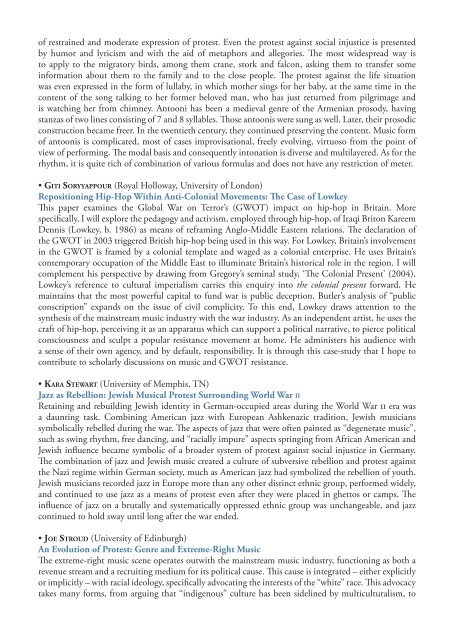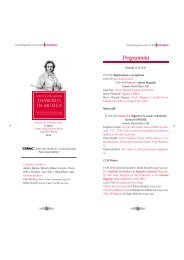PROGRAMME - Centro Studi Opera Omnia Luigi Boccherini
PROGRAMME - Centro Studi Opera Omnia Luigi Boccherini
PROGRAMME - Centro Studi Opera Omnia Luigi Boccherini
You also want an ePaper? Increase the reach of your titles
YUMPU automatically turns print PDFs into web optimized ePapers that Google loves.
of restrained and moderate expression of protest. Even the protest against social injustice is presentedby humor and lyricism and with the aid of metaphors and allegories. The most widespread way isto apply to the migratory birds, among them crane, stork and falcon, asking them to transfer someinformation about them to the family and to the close people. The protest against the life situationwas even expressed in the form of lullaby, in which mother sings for her baby, at the same time in thecontent of the song talking to her former beloved man, who has just returned from pilgrimage andis watching her from chimney. Antooni has been a medieval genre of the Armenian prosody, havingstanzas of two lines consisting of 7 and 8 syllables. Those antoonis were sung as well. Later, their prosodicconstruction became freer. In the twentieth century, they continued preserving the content. Music formof antoonis is complicated, most of cases improvisational, freely evolving, virtuoso from the point ofview of performing. The modal basis and consequently intonation is diverse and multilayered. As for therhythm, it is quite rich of combination of various formulas and does not have any restriction of meter.• Giti Soryyappour (Royal Holloway, University of London)Repositioning Hip-Hop Within Anti-Colonial Movements: The Case of LowkeyThis paper examines the Global War on Terror’s (GWOT) impact on hip-hop in Britain. Morespecifically, I will explore the pedagogy and activism, employed through hip-hop, of Iraqi Briton KareemDennis (Lowkey, b. 1986) as means of reframing Anglo-Middle Eastern relations. The declaration ofthe GWOT in 2003 triggered British hip-hop being used in this way. For Lowkey, Britain’s involvementin the GWOT is framed by a colonial template and waged as a colonial enterprise. He uses Britain’scontemporary occupation of the Middle East to illuminate Britain’s historical role in the region. I willcomplement his perspective by drawing from Gregory’s seminal study, ‘The Colonial Present’ (2004).Lowkey’s reference to cultural imperialism carries this enquiry into the colonial present forward. Hemaintains that the most powerful capital to fund war is public deception. Butler’s analysis of “publicconscription” expands on the issue of civil complicity. To this end, Lowkey draws attention to thesynthesis of the mainstream music industry with the war industry. As an independent artist, he uses thecraft of hip-hop, perceiving it as an apparatus which can support a political narrative, to pierce politicalconsciousness and sculpt a popular resistance movement at home. He administers his audience witha sense of their own agency, and by default, responsibility. It is through this case-study that I hope tocontribute to scholarly discussions on music and GWOT resistance.• Kara Stewart (University of Memphis, TN)Jazz as Rebellion: Jewish Musical Protest Surrounding World War iiRetaining and rebuilding Jewish identity in German-occupied areas during the World War ii era wasa daunting task. Combining American jazz with European Ashkenazic tradition, Jewish musicianssymbolically rebelled during the war. The aspects of jazz that were often painted as “degenerate music”,such as swing rhythm, free dancing, and “racially impure” aspects springing from African American andJewish influence became symbolic of a broader system of protest against social injustice in Germany.The combination of jazz and Jewish music created a culture of subversive rebellion and protest againstthe Nazi regime within German society, much as American jazz had symbolized the rebellion of youth.Jewish musicians recorded jazz in Europe more than any other distinct ethnic group, performed widely,and continued to use jazz as a means of protest even after they were placed in ghettos or camps. Theinfluence of jazz on a brutally and systematically oppressed ethnic group was unchangeable, and jazzcontinued to hold sway until long after the war ended.• Joe Stroud (University of Edinburgh)An Evolution of Protest: Genre and Extreme-Right MusicThe extreme-right music scene operates outwith the mainstream music industry, functioning as both arevenue stream and a recruiting medium for its political cause. This cause is integrated – either explicitlyor implicitly – with racial ideology, specifically advocating the interests of the “white” race. This advocacytakes many forms, from arguing that “indigenous” culture has been sidelined by multiculturalism, to









